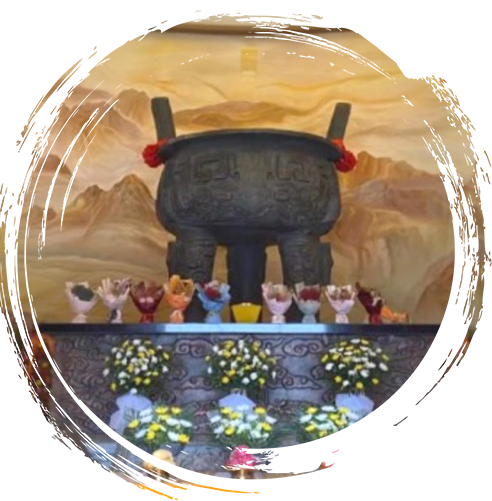
The Yellow Emperor Temple is the core building complex of the cultural tourist attractions of Zhonghua County. It is composed of Shizu Palace, Qianyuan Palace, and Kunyuan Palace, which indicates that the Yellow Emperor unified the three tribes, cast a Ding of heaven, world, and man, and established the Chinese nation. The project forms a pattern of “palaces in the south and mausoleum in the north” with the Yellow Emperor Mausoleum in Qiaoshan. The Literati Court is built on the left of the Shizu Palace, and the Warrior Court on the right, which represents both liberal arts and martial arts, and blesses the world.
It is mainly used to showcase the Yellow Emperor’s birth, growth, invention, cultivation and planting teaching, and the making of clothes. He united the Yan Emperor to fight against Chi You, and finally united the three tribes. They united the Chinese nation and started the Chinese civilization as they cast a Ding on Jing Mountains. Through the remembrance of the roots of the Chinese nation, we promote the culture of the Yellow Emperor as the soul of the Chinese nation, and inspire the descendants of Yan and Huang to strive for their nation.
It is mainly used to show the development of Chinese civilization from the formation of the world (Pangu breaking the sky and Nvwa creating man and woman) to the beginning of the civilization (three sovereigns and five emperors, the prosperous age of Yao and Shun, the time of using the bow drill, and Shen Nong tastes hundreds of plants). “Jing Mountains” as the epitome of five thousand years of Chinese civilization, are used to show the origin of the Chinese nation.
By displaying the evolution and development of pedigree (the origin of the surname), the astronomy calendar, medical origin, the development history of characters, architecture and clothing, it is built to show the national cultural inheritance of the Chinese nation, which is passed on from generation to generation and innovated again and again.
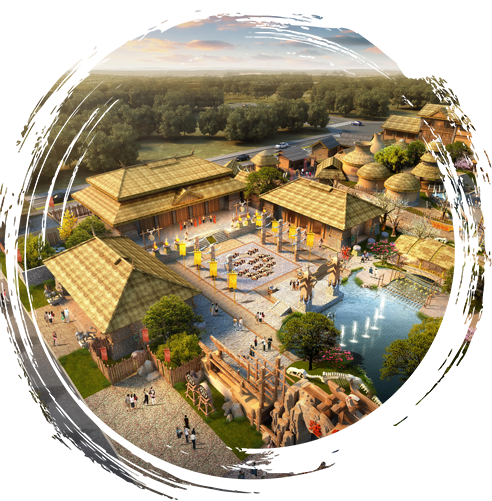
The Ancient Tribes are planned to shape the cultural experience zone of the ancient tribes in China, through the restoration of historical relics, the creation of ancient life scenes and other creative designs. The Ancient Tribes B&B (cultural theme hotel), bonfire square, and handicraft workshops, present an unprecedented large-scale prehistoric cultural living experience area for tourists, so that tourists can explore the way our ancestors lived on this land and feel the charm and essence of Chinese civilization.

The Sinology Hall is a cultural exchange base established with traditional Chinese culture as the core and promoting Chinese culture as the purpose. It is used to hold seminars, conferences, and forums and is an important research place for various lectures on the classics of sinology, cultural exchange salons, art, cultural and vocational training and traditional cultural research and exchange related to the culture of the Yellow Emperor, which can hold conferences and seminars of various scales and forms.
The project adopts the tradition to “interpret” modern artistic conception in its design, and follows the characteristics of Chinese furnishings, which are symmetrical and yin-yang balance. It embellishes the elegant and exquisite oriental charm with ancient furniture, porcelain, screens, window lattices, coffee tables, and calligraphic works.
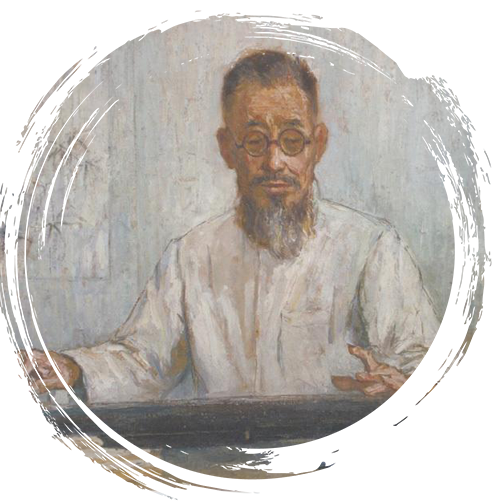
Liu Shaochun (1901-1971), named Shao, who styled himself as Shaochun and Deyi, was a modern specialist in Guqin in China, the tenth heir to the Guangling Guqin Sect, the master of the modern Guangling Guqin Sect, and a native of Beilingbao, Fuping County, Shaanxi Province. He went to Yangzhou with his father to study business in 1914. In 1928, he learned the instrument from Sun Shaotao for about three years. His style is mature and steady, with ups and downs. His right hand was vigorous and left hand is delicate when playing the instrument, which promotes the ups and downs, the beauty and delicacy, the combination of rigidity and softness of the Guangling Guqin Sect, and maximizes the aesthetic charm of the Guangling Guqin Sect. He was good at performing Song of a Woodcutter (Qiao Ge), so he is also called “Liu Qiaoge”. Some of his works are preserved in the hall, such as Qiao Ge, Resting Ansers on the Beach, A Chant of Living in the Mountain, A Song to Plum Blossoms, Wutong Leaves Dancing in the Autumn Wind, and A Sad Song of Mozi. Liu Shaochun Memorial Hall is located in Zhonghua County, which shows that the Guqin master’s wish to be buried in his hometown, and further develops the Chinese Guqin culture.
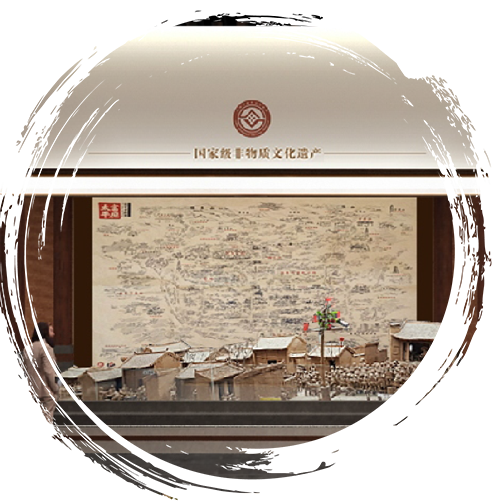
The Fuping Intangible Cultural Heritage Exhibition Hall, jointly built by Qinzheng Group and the Cultural Bureau of Fuping County, brings together two national-level intangible cultural heritage projects of A’gongqiang and Fuping Stone Carvings, as well as provincial and municipal intangible cultural heritage projects like Zhu’s orthopedics, old temples and old drums, sugar pot sugar, old temple papermaking, and Fuping songs. The exhibition center passes on Fuping’s intangible cultural heritage through physical exhibitions, multimedia and other methods. It is also an important research base for primary and middle school students to learn and inherit the intangible cultural heritage. Through the eyes of children, Fuping’s dedication and contribution to promoting craftsmanship and rejuvenating the Chinese culture is reflected again.
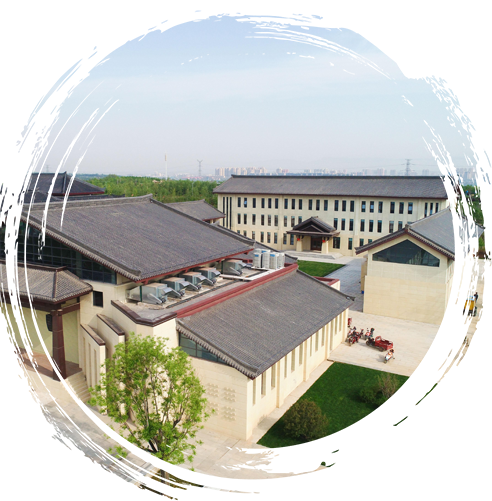
A’gongqiang, also known as “E’gongqiang”, is a unique form of operas in Fuping. According to research, A’gongqiang is derived from the tunes sung by the singeing girls of E’pang Palace in the Qin Dynasty. In 2006, it was included in the list of the first batch of national intangible cultural heritages. The Stage of Zhonghua County integrates performance, collection, teaching, and physical display into one. In line with the idea of protecting intangible cultural heritage, edutainment, and inheriting intangible cultural heritage, it gathers many local opera performers to carry out processes such as concentrated creation, arrangement, and performance of the ancient history of the ancient genre of music, A’gongqiang. At the same time, it incorporates the characteristics of learning, inheritance, and scene interaction. It is another lively cultural and business card of the cultural tourist attractions of China County.
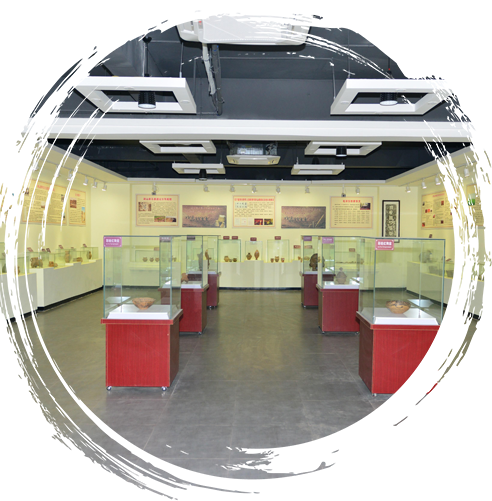
The Yellow Emperor Culture Museum of China County is a non-state-owned historical museum about the culture of the Yellow Emperor. The completion of this museum fills the gap in displaying the culture of the Yellow Emperor thorough a professional museum. The exhibits in the museum mainly include various prehistoric stone grinding production tools, living utensils, painted red pottery, and gray pottery in the Jing Mountains and Shichuan River during the Yangshao culture period. They are the symbols marking the Chinese civilization’s overcoming ignorance and barbarism and being developed into the Neolithic, the era of farming and animal husbandry. They embody the wisdom of the matriarchal clan of the Yangshao culture during the Neolithic in the middle reaches of the Yellow River and open a new era in the history of human life.